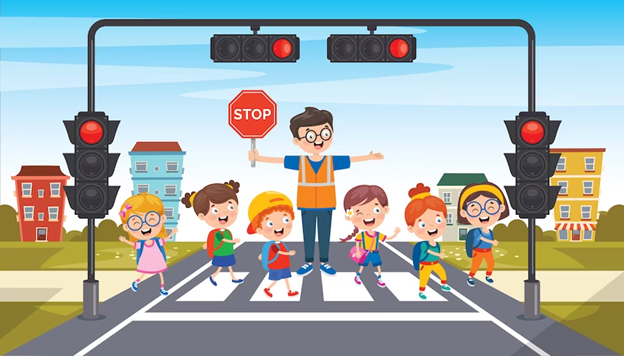Road safety for children is a responsibility that is shared between parents, educators, and the community. We must keep in mind children’s safety on the roads.
Parents and educators should teach children about road safety rules such as looking both ways before crossing the road, using zebra crossings, obeying traffic signals, and walking on footpaths. Young children should be supervised by a responsible adult while crossing the road or walking on the road. Children below 10 years old should not be allowed to cross the road alone. Children should wear the right gear while cycling, such as helmets and clothing with reflective bands. This will help them to be visible to drivers and protect them from head injuries in case of a fall. Parents should ensure to choose safe routes for children to walk or cycle to. This could include footpaths or cycle lanes. Adults should lead by example and demonstrate safe road behaviour such as following traffic rules, using zebra crossings, and wearing seat belts in cars. The community must ensure the safety of children on the roads by providing safer road infrastructure, supporting road safety campaigns, and reporting any dangerous road conditions to the authorities.
Ensuring road safety for children requires a joint effort from parents, teachers, and the community. By following and teaching children about road safety and the rules, we can help prevent accidents and keep children safe on the roads.
Importance of Road Safety for Kids
Road safety for kids is important as they are vulnerable to accidents while crossing or walking on the road. It is crucial for parents, caregivers, and educators to teach children about road safety measures to ensure their safety and well-being.
Here are some reasons why road safety for kids is important:
- Protects against accidents:
- Develops responsible behaviour:
- Builds confidence:
- Prepares for the future:
Children are at a higher risk of accidents due to their small size and lack of experience in identifying potential dangers on the road. Teaching them road safety measures helps them avoid accidents and stay safe.
Teaching kids road safety rules encourages them to develop a responsible attitude towards their safety and the safety of others. It helps them understand the importance of following rules and being responsible for their actions.
Road safety education helps children to gain confidence in crossing the road, walking on footpaths, and cycling on the road. This confidence helps them to navigate through their surroundings safely.
Children who learn about “road safety for kids” at a young age are better prepared for the future when they start driving. They will understand the importance of obeying traffic laws and being attentive while on the road.
How to teach road safety rules for kids
Teaching road safety rules for kids requires a practical and interactive approach. Here are some tips to help teach road safety rules for kids:
- Use age-appropriate language:
- Demonstrate safe behaviour:
- Make it fun:
- Practice in real-life situations:
- Use visual aids:
- Reinforce positive behaviour:
- Repeat and reinforce:
Use language that is appropriate for the child’s age and comprehension level. Avoid using complex words and phrases that may confuse or intimidate them.
Lead by example and demonstrate safe road behaviour such as following traffic rules, using zebra crossings, and wearing seat belts in cars. Children learn best by seeing and copying behaviour.
Use games, role-play, and other fun activities to teach road safety rules. For example, you could use a toy car and traffic lights to demonstrate traffic signals and teach kids when it is safe to cross the road.
Provide opportunities for kids to practice road safety rules in real-life situations. For example, while walking to school or the park, teach them to identify potential hazards and practice crossing the road safely.
Use pictures, videos, and other visual aids to help children understand road safety rules. This can be particularly helpful for younger children who may have difficulty understanding verbal instructions.
Praise children when they follow road safety rules correctly. This will encourage them to continue practising safe behaviour on the road.
Repeat and reinforce road safety rules regularly to help children remember them. Encourage them to ask questions if they are unsure or need clarification.
Teaching road safety rules for kids requires a practical and interactive approach. By using age-appropriate language, demonstrating safe behaviour, making it fun, practising in real-life situations, using visual aids, reinforcing positive behaviour, and repeating and reinforcing rules, children can learn road safety effectively and stay safe on the road.
Basic Traffic rules for kids
Teaching traffic rules for kids is essential to ensure their safety while walking or cycling on the road. Here are some of the most important traffic rules for kids to ensure their safety:
- Look both ways before crossing the road:
- Use pedestrian crossings:
- Walk on footpaths:
- Wear reflective clothing:
- Wear appropriate safety gear:
- Stay alert:
- Follow traffic rules:
Teach kids to look left, right, and left again before crossing the road, even if there is a zebra crossing or traffic light. This will help them to identify any potential dangers and avoid accidents.
Teach kids to use pedestrian crossings or zebra crossings while crossing the road. Encourage them to wait for the green signal before crossing the road.
Kids should be encouraged to walk on footpaths whenever possible. If there is no footpath, they should walk on the side of the road facing oncoming traffic.
If children are walking or cycling in the dark, encourage them to wear reflective clothing or carry a torch to make themselves visible to drivers.
If children are cycling, they should wear appropriate safety gear such as helmets, elbow and knee pads, and reflective clothing.
Teach children to stay alert while walking or cycling on the road. They should avoid using mobile phones or listening to music while on the road.
Teach children to obey traffic signals and signs such as stop signs, yield signs, and speed limits. Encourage them to be patient and wait for their turn while crossing the road.
Conclusion
Teaching traffic rules for kids is crucial in ensuring their safety while walking or cycling on the road. By following these rules, kids can avoid accidents and stay safe while on the road.
At Euroschool we believe, teaching road safety for kids and the various measures it includes, is crucial to ensuring their safety and well-being. It helps them develop a responsible attitude towards their safety and the safety of others.










